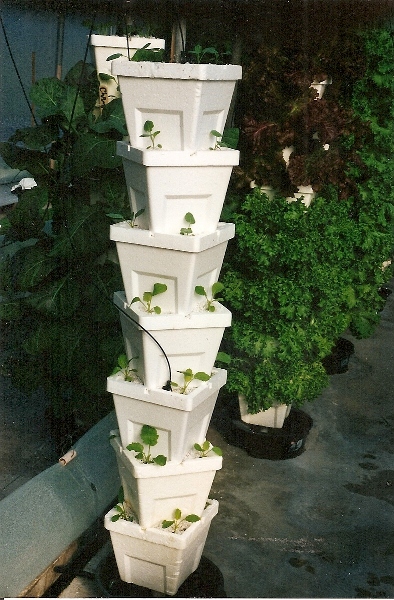
Vertical hydroponic growing systems have been in wide use for a number of years, enabling the growing of plants in small spaces. Such a growing system may be as simple as a series of horizontal rooting pipes mounted on an “A” frame, while others are a series of rooting vessels mounted on top of each other to form a tower (Jones, 2012, see pages 32-33).
Another hydroponic vertical growing system is formed by stacking square buckets set 90 degrees from each other, each corner of the bucket forming an opening for setting a plant. Various bucket sizes and shapes are used to vary the size of the open area for setting plants.
The rooting medium can be either organic or inorganic, perlite being the more commonly used since it has good water retaining and drainage properties as well as being light weight, an important factor when stacking a number of buckets on top of each other. The nutrient solution is periodically applied at the top of the tower of buckets to flow down through the stack, providing needed water and essential elements for the rooted plants. To ensure water and nutrient element sufficiency when growing a high cash crop, such as tomato, a drip irrigation system may be employed with a dripper placed at each plant station.
Although about any plant species can be set in these various tower configurations, lettuce and herbs are most commonly planted. For decorative purposes, flowering or foliage plants are set in each plant station.
All these growing systems have their unique operating characteristics that correlate with the method of providing the water and essential nutrient elements required by the growing plant. For example, with the Tower Garden system, the operating principle is aeroponics, applying the nutrient solution as a spray on the exposed roots. The fineness of the water droplets will determine the extent of root retention which may not be sufficient to maintain plant turgidity when the atmospheric demand is high (Jones, 2012, see pages 24-25).
Discharging a nutrient solution at the top of the tower requires a determination of frequency and volume applied, with the flow of nutrient solution down through the rooting medium resulting in a change in elemental and oxygen content, therefore possibly having an adverse effect on the plants at the bottom of the tower. In addition, the nutrient solution flowing down the rooting medium may not be uniformly distributed, creating sections of the rooting medium excessively wet while others remain relatively dry.
For ensuring sufficient nutrient solution distribution within the tower, the volume of nutrient solution applied is such to create an outflow at the base, the outflow being either discarded or collected for recirculation. If a dripper is placed at each plant station, sufficient nutrient solution will be applied to provide for that plant only with little or no discharge from the base of the tower. With either nutrient solution application method, the rooting medium in the tower may require periodic leaching with pure water to remove accumulated salts.
To ensure equal light exposure in a garden of towers that shade each other, the towers are either slowly turned continuously or periodically.
Although vertical growing systems have their advantages when dealing with limited space, they have not proven to be financially viable for the commercial production of food products, but can be of value to the home gardener, who can construct his own vertical growing unit using items readily available. Managing the growing system for option plant production can be a challenge, such as selection of the nutrient solution formulation and determining its use factors (Jones, 2012, see pages 48-50).
J. Benton Jones, Jr. has a PhD in Agronomy and is the author of several books including Hydropopnic Handbook: How Growing Systems Work.
References:
Jones, J. Benton, Jr. 2012. Hydroponic Handbook: How hydroponic growing systems work. GroSystems, Inc., Anderson, SC.
Vigilante, R. 2012. Aeroponics at O’Hare. Organic Gardening 59(2):83. Feb/Mar 2012.




Comment here